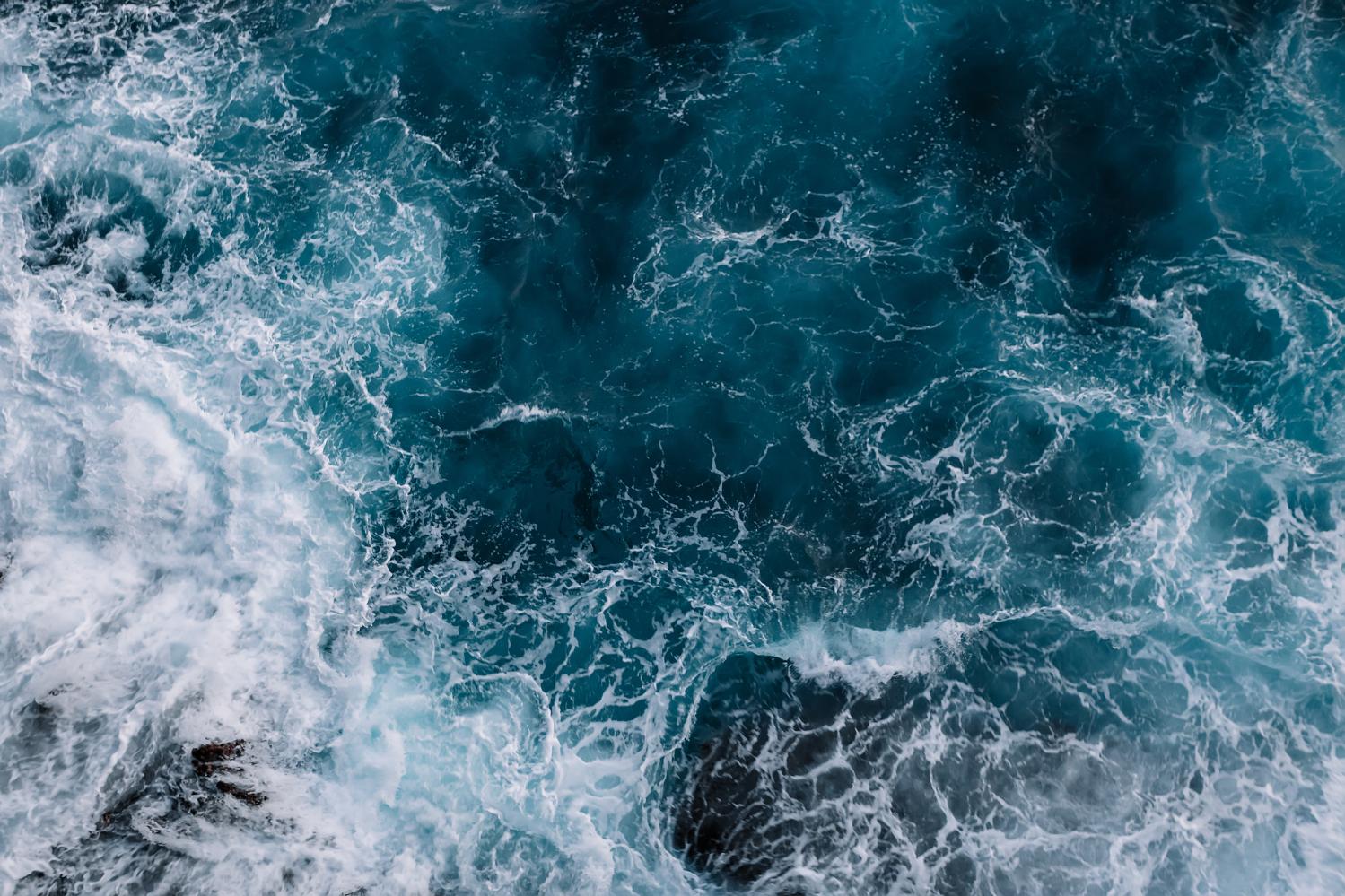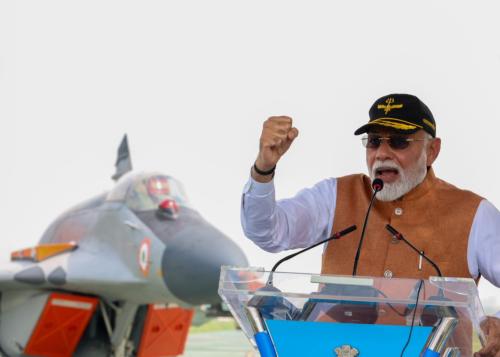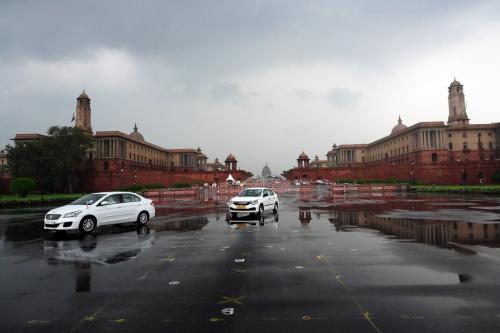Content from the Brookings Institution India Center is now archived. After seven years of an impactful partnership, as of September 11, 2020, Brookings India is now the Centre for Social and Economic Progress, an independent public policy institution based in India.
This chapter first appeared in a book titled “Purbasa East meets East – Synergising the North-East and Eastern India with the Indo-Pacific”. The views are of the author(s).
Thank you for the kind invitation to address this august gathering in Bhubaneshwar today, and my Congratulations to Ambassador Lalit Mansingh and his colleagues at the Kalinga International Foundation on this wonderful new initiative.
There are perhaps few better places than Odisha to discuss India’s growing role in world affairs. After all this was the historical site of the Mauryan Emperor Ashoka’s war against the Kalingas. It was after that conflict that Ashoka adopted his dhamma-his faith-grounded in Buddhism. Edicts to spread his philosophy were commissioned and displayed as far as today’s Afghanistan and Nepal and as far South as Karnataka, and they appeared in different languages including Greek and Aramaic. Contrary to popular myth, these were not declarations of Pacifism. Rather, Ashoka’s edicts called for just and limited warfare, but they also elaborated upon norms regarding how to manage conflict. He made startling claims not just about sending missionaries but about links across the Hellenistic world, as far as today’s Greece and Libya. Indeed, Ashoka’s efforts may represent the first recorded attempt in history to establishing a liberal international order. In many ways India’s recorded engagements with the world can be traced to this region.
Odisha is also proof that economics and security have always been deeply intertwined in Asia and Indian Ocean Region. European traders were initially drawn to India between the 15th and the 18th centuries by textile exports to finance the spice trade from South East Asia. The likes of Portugal and England established trading outposts- factories- along the East Coast of India. The first English outpost was in Masulipatnam in Andhra Pradesh, but their presence expanded to include such places as Pipili and Hariharpur in today’s Odisha not very far from Bhubaneshwar. The English and other Europeans tapped into existing networks established by Indian traders with South East Asia. The first East India Company vessel that arrived in Aceh found Bengali, Gujarati and Malabari traders already present. Pre- Existing trade networks already extended across a sizeable Indo- Pacific region, from Formosa to Vietnam, from Siam to Sumatra, from Malacca to the Malabar and from Gujarat to Hormuz.
European traders were initially drawn to India between the 15th and the 18th centuries by textile exports to finance the spice trade from South East Asia.
Today we are rediscovering this natural commercial and political links and the Indian ocean has grown in relative importance. It is now a major conduit for sea borne International trade- which has seen a four-fold increase since 1970- between the largest centres of economic activity in the Pacific and both sides of the Atlantic Ocean. Energy flows are particularly important, with about 40 percent of world oil passing through strategic checkpoints in and out of the Indian Ocean. The Ocean is also a valuable source of natural resources, accounting for 15% of the World’s fishing and significant mineral resources. This region is also important in its own right, home to two billion people in some of the fastest growing parts of the World: Southeast and South Asia, East and South Africa and West Asia.
However, there are plenty of challenges, including natural and humanitarian disasters. Two of the most devastating disasters in recent decades were in the Indian Ocean: the 2004 Indian Ocean Tsunami, which killed 228,000 people and Cyclone Nargis in Myanmar which killed about 138,000. Humanitarian Assistance and Disaster Relief (HADR) operations have been required around the region, from Yemen to Sri Lanka and the Maldives to Bangladesh. Piracy in the Indian Ocean has been among the many other threats and led to about US $6 billion in annual losses to the shipping industry between 2010 and 2012. And there are growing concerns about security competition increasing exponentially, with the greater activity of China’s People’s Liberation Army- Navy (PLA-N) and its investment in potentially ‘dual use ‘port infrastructure- infrastructure that can be used for both civilian and military purposes in- such places as Djibouti, Gwadar, Hambantota, Kyaukpyu and the Maldives.
India has consequently started to pay greater attention to the Indian Ocean. In decades past, there were famously attempts at creating a zone of peace, while the 1980s saw a considerable amount of Indian interventionism and gunboat Diplomacy in the region, including in Sri Lanka and the Maldives. But Indian efforts at regional leadership and engagement have received an added impetus over the past decade, in response to some of these new developments. The clearest articulation of India’s Indian Ocean policy was, perhaps, made by Prime Minister Modi in a speech in Mauritius in 2015. Explicitly and implicitly, he outlines a number of objectives, including securing the Indian Ocean against both non-state actors and growing naval competition, improving HADR responses, ensuring the equitable harnessing of natural resources, and taking fuller advantage of the economic opportunities on offer.
Consequently, we have seen India assume a larger role as a security provider in the Indian Ocean region. These include, efforts at building capacity, improving interoperability and exchanging information with a number of security partners, not least the USA, Japan and Australia, but also several countries in South East and South Asia, the Gulf and Africa. With the more capable navies of the region, India’s co – operation on Anti-Submarine Warfare (ASW) and maritime domain awareness (MDA) have increased in recent years. India has entered into or operationalised logistics agreements with the USA, France, Singapore giving its navy greater reach. It provides equipment and technical support to a number of armed forces, including coast guard vessels to Mauritius, aircraft to Seychelles, and assistance to Myanmar. It conducts joint patrols and has navy to navy contacts with Indonesia and Thailand. India trains pilots of Sukhoi aircraft and Kilo class submariners from Vietnam. It has bilateral MDA arrangements with Sri Lanka and the Maldives that have persisted despite political differences. And, it has entered into a host of white shipping arrangements, allowing India to better monitor military activity and illicit shipping.
The Indian Navy’s operational tempo has also increased. This extends to disaster reliefs following cyclones in Sri Lanka, Bangladesh and Myanmar, a water crisis in the Maldives and a civil conflict in Yemen. The Navy’s presence in South East Asia and the Western Pacific has also grown: in 2017, an Indian Naval vessel was East of Malacca Strait for over half of the year. The MILAN naval exercise is an Indian-hosted multilateral effort to build confidence and cooperation in the region. For many years, India has been engaging in counter piracy and counter-smuggling operations in the Gulf of Aden and the Western Indian Ocean. Year-round deployments in several zones are now a reality and the acquisition of maritime surveillance aircraft has enhanced India’s reconnaissance capabilities across the Indian Ocean while bringing down operational costs.
Of course, much more needs to be done. India’s resources are still limited, and the naval budget in particular requires revisiting, given the relative importance of the maritime domain. Another area of urgent attention concerns maritime connectivity and infrastructure, including increased port capacity and restrictive cabotage policies. Despite recent growth, all of India’s ports still move only about one third the number of containers in Singapore. But, despite these limitations, which are being addressed, efforts are being underway for India to play a bigger role in the Indian Ocean and the Pacific Oceans from a political, economic and security perspective.
India’s resources are still limited, and the naval budget in particular requires revisiting, given the relative importance of the maritime domain.
The history of Odisha has a cautionary tale for us. As long as the Indian Ocean remained an open and competitive space, India was relatively secure. To punish the Portuguese for piracy, the Mughals would simply retaliate by limiting their activity on land, thus benefiting their competitors: the French, English, the Dutch and the Danes. But, as soon as England managed to establish an effective monopoly of maritime trade in the Indian Ocean following the Carnatic Wars with the French, it was able to translate its predominance to the control of the land. In just a few decades from the 1750s, British presence in India went from a few small garrisons to the direct governance and administrative control of Bengal, Bihar and several other regions. If there is a lesson to be drawn from history, it is that India today cannot afford to be complacent about the growing maritime cooperation in the Indian Ocean. Recognising the importance of the Indo- Pacific by expanding strategic horizons, prioritising the maritime sphere and playing a role in the balance of power is therefore necessary. This will require further investments in the Indian Ocean, improving connectivity and economic inter linkages, and deepening security partnerships with a variety of actors who share similar concerns.
The Brookings Institution is committed to quality, independence, and impact.
We are supported by a diverse array of funders. In line with our values and policies, each Brookings publication represents the sole views of its author(s).





Commentary
Op-edMaritime connectivity and security in the Indo-Pacific
January 9, 2019